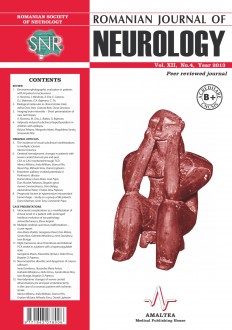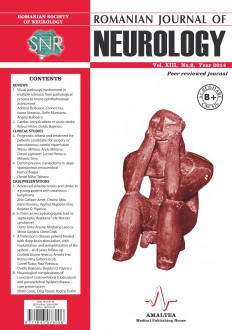SELECT ISSUE

Indexed

| |

|
|
|
| |
|
|
|

|
|
|
|
|
|
| |
|
|
HIGHLIGHTS
National Awards “Science and Research”
NEW! RJN has announced the annually National Award for "Science and Research" for the best scientific articles published throughout the year in the official journal.
Read the Recommendations for the Conduct, Reporting, Editing, and Publication of Scholarly work in Medical Journals.
The published medical research literature is a global public good. Medical journal editors have a social responsibility to promote global health by publishing, whenever possible, research that furthers health worldwide.
HEMODYNAMIC CHANGES OF SEVERE CAROTID ATHEROMATOSIS PRE AND POST ENDARTERECTOMY IN THE CASE OF A CORONARY PATIENT WITH ISCHEMIC STROKE
Marius Militaru, Anda Militaru, Stanca Ples, Gratian Miclaus, Mihaela Simu and Daniel LIGHEZAN
ABSTRACT
Nearly 25%-30% of ischemic strokes are due to atherosclerosis of the carotid bifurcation. Cerebrovascular reactivity (CVR) is an indicator for testing hemodynamic status of cerebral circulation. The purpose of the presentation was to determine the effects of CEA (endarterectomy) on cerebral hemodynamics with cerebral hemodynamic change tracking, by measuring the average flow velocities (MFV) in the ipsilateral and contralateral middle cerebral artery (MCA) severe carotid stenosis and pulsatility index (PI) by the help of the Transcranian Doppler (TCD) and the study of CVR (cerebrovascular reactivity) by performing BHT (Breath-holding test) both before and at 7 days and at 2 and 4 months post intervention, as well as cerebral hemodynamic parameters determining through Cerebral Perfusion CT and correlation with risk factors and prior stroke event. Using ultrasound methods ECD (Extracranial Doppler) and TCD (Transcranial Doppler) and imaging (Perfusion Cerebral CT, angioCT cervical region, angiocoronarography) allowed: increased detection of patients at risk of stroke and myocardial infarction, stroke diagnosis of ischemic sites, the calculation of hemodynamic parameters of cerebral circulation at patients with coronary stenosis and carotid stenosis, occlusion with stroke up, TIAs or stroke risk and heart attack.
Keywords: carotid stenosis > 70%; transcranian Doppler – breath-holding test, cerebrovascular reactivity, CT perfusion, carotid endarterectomy

